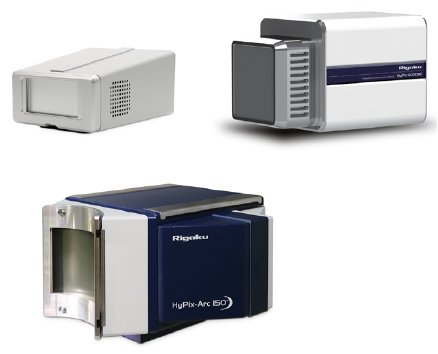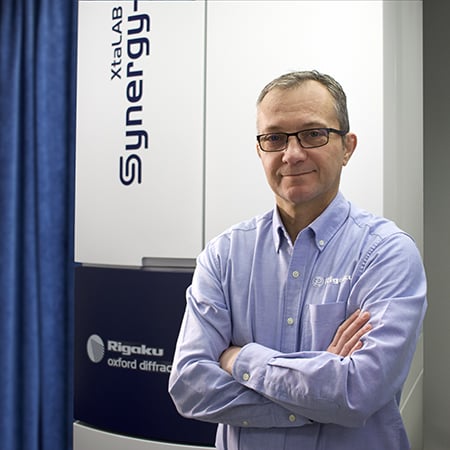Application Note SMX024
Introduction
For the correct experimental determination of the charge-density distribution within crystalline structures, reliable high-resolution diffraction data are imperative. The refinement of the true, experimental charge-density requires the application of sophisticated models, like the Hansen & Coppens Multipole Model (Acta Cryst. (1978) A34, 909–921)or Coppens & Volcov X-ray constrained wave functions (Acta Cryst. (2004) A60, 111-119). Only such models allow for the deconvolution of the vibrational smearing from the anisotropic atomic density or the and subsequently revealing insight system wave function the vibrational smearing from the anisotropic atomic density or the revealing insight to the chemical properties. The collection of such high-resolution data impose strict demands on the experimental setup. While perfect crystal quality is sometimes not achievable, the development of advanced hardware and software clears the path for novel charge-density determinations.
The Rigaku XtaLAB Synergy series provides the fusion of high-end hard- and software, providing new possibilities for experimental charge-density determination.
On the importance of good data for experimental charge density
Refining accurate models against experimental data has always been a challenging endeavor and it continues to be one. As theoretical models are getting more and more reliable and accessible, challenging theoretical concepts with experimental results requires great confidence in these results and absolute certainty of the experimental data.
Therefore, a range of excellent quality-checking tools has been employed for experimental charge-density over the years in order to confirm the validity of models and data. On the other hand, this development is accompanied by an ever-increasing number of parameters, included in the refinements.
The investigation of heavy atom element d-and f-orbital populations or the anisotropic displacement of hydrogen positions potentially add a great many parameters to the refinement. Still, in the analysis of the models, minute differences in the density distribution are discussed to characterize intra- and intermolecular interactions. Hence the demand on the data quality is ever increasing and can only be met with improved hardware and realistic data processing.
One key problem of all approaches to experimental charge-density investigations is the deconvolution of the molecular density from the thermal movement and smearing. Most contemporary approaches, like X-ray Constrained Wave function fitting (XCW) or the Hansen & Coppens multipole model, rely on elaborate descriptionsof the molecular density by Hirshfeld-partitioning (Isr. J.Chem. (1977) 16,198–201) of the wave function orspherical harmonics. The thermal displacement on the other hand is described by isotropic, anisotropic orelaborate anharmonic Gram-Charlier temperature factors.
The deconvolution of the anisotropic atomic density from the vibrational displacement is predominantly constituted via the difference of scattering factor as illustrated in Figure 1. The diffuse anisotropic atomic density is constituted by the valence electrons, whose scattering factor approaches zero at medium resolution. The isotropic core density and its non-isotropic displacement on the other hand feature a non-zero scattering factor throughout the whole resolution range. Therefore, the anisotropic molecular density is predominantly refined with relatively few low-resolution data. This is only made possible by the thermal motion being fitted predominantly to high-resolution data.
 Figure 1: Resolution dependency of carbon atomic form factors (Acta Cryst. (1998), A54, 646).
Figure 1: Resolution dependency of carbon atomic form factors (Acta Cryst. (1998), A54, 646).
In order to deconvolute valence density from thermal displacement, experimental charge-density refinements require high-quality data from a vast resolution range. As the atomic scattering factors for high resolution reflections tend to be very small, these reflections are very weak. Therefore, good crystal quality, highly sensitive, noise-free and high-resolution detectors, as well as stable and intense radiation sources are required to make them visible. The low-resolution reflections of such high-quality crystals on the other hand tend to be extremely strong and therefore regularly meet or even exceed the dynamic range of popular phosphor-based integrating detectors. These instrument types require special experimental approaches to overcome the hardware limitations: low resolution data often need to be recorded, by appending additional extremely fast scans or artificially lowering the intensity with attenuators. Using scintillation detectors, the strongest reflections are regularly determined with low redundancy and inferior data quality. In the context of relatively few, low-resolution reflections bearing all information about the anisotropic atomic density, this praxis is sub-optimal. At the same time, scintillation detectors are always affected by electronic noise, ever growing with exposure time and indistinguishable from—and therefore often obscuring—reflection intensities. Both experimental challenges—the determination of extremely weak, as well as extremely strong reflections—can be met by changing from scintillation detectors to direct detection hybrid photon counting detectors. Rigaku implemented this groundbreaking new technology in the HyPix detectors create new possibilities for the collection of high-resolution, high quality data that are required for experimental charge-density.
Advances in hardware - improved detector technology
The determination of the experimental charge-density demands the highest quality of data possible. Vice versa, charge-density data collections impose the highest challenges for diffraction hardware and software.
As the crystal quality needs to be very good, the lowresolution region features extremely strong reflections, while at the same time, the high-resolution region features very weak reflections. Both extremely strong and weak reflections need to be determined with excellent accuracy and precision. These requirements can only be met—without making compromise in data quality—by a truly photoncounting hybrid pixel array detector. Only such detectors combine an extremely high dynamic range with no noise and high sensitvity to determine the true intensity of all reflections between 1 and 10⁶ X-ray photons per pixel-second. Contemporary indirectly detecting detectors can register up to 10⁴ X-ray photons per pixel-second, therefore, the dynamic range of hybrid pixel detectors is many orders of magnitude higher and overexposure an extremely rare phenomenon.

Figure 2: A Cytidine diffraction image on HyPix6000HE at 10s, resolution range up to 0.48 Å.; gray scale 0 (gray) to 10 (black) B. Intensity Profile view of strong reflection - highest intensity 58989 X-ray photons. C. Intensity profile view of weaker reflection—highest intensity 7 X-ray photons.

Figure 3. Rigaku HyPix series detectors: HyPix Bantam, HyPix 6000HE and HyPix Arc 150°.
Advances in hardware – the most brilliant in-house radiation sources
Experimental charge-density refinements require highquality data from a vast resolution range. However, quite often the diffraction power of interesting crystals is not optimal. In order to observe significant intensities at high resolution, high-brilliance radiation sources with molybdenum or silver radiation are required. Rigaku is the market leader in high-intensity X-ray sources. We combine the best rotating anodes with the finest multilayer optics in order to achieve the highest intensity and brilliance for in-house sources. Developments in the hardware durability, service infrastructure and serviceability result in a low and predictable downtime of 2-3 days per year. Over seven decades of development of rotating anodes result in the most powerful, stable and reliable X-ray sources for your laboratory.
The PhotonJet high-end radiation sources push the limits for the collection of high-resolution data. The charge-density investigation of new, interesting compounds is made feasible simply by the superior intensity of Rigaku radiation sources.
User-inspired software - made for charge-density
CrysAlisPro, which is freely available, provides all tools for the collection and processing of elaborate single-crystal diffraction experiments. Each charge-density determination starts with the search for a suitable crystal, and CrysAlisPro provides special tools for the initial screening. From the pre-experiment, the data quality is accurately predicted. An optimized data-collection strategy, optimized exposure time and a reliable experiment duration is calculated during strategy planning—invaluable information with restricted sample-lifetime or instrument access.

Figure 4: PhotonJet-S 50 W microfocus sealed-tube source, PhotonJet-R 1.2 kW microfocus rotating anode, and FR-X 2.97 kW microfocus rotating anode sources.
The HyPix detector series combines the requirements of experimental charge-density with an excellent spatial resolution of 100 μm. As illustrated in Figure 2, very strong and weak reflections are recorded on the same image. The background noise merely stems from stray radiation and air scattering—not from electronic noise as in scintillation detectors. It is therefore zero or close to zero for most parts of the detector (see Figure 2). The HyPix is therefore an excellent choice of detector for experimental charge-density determination.

